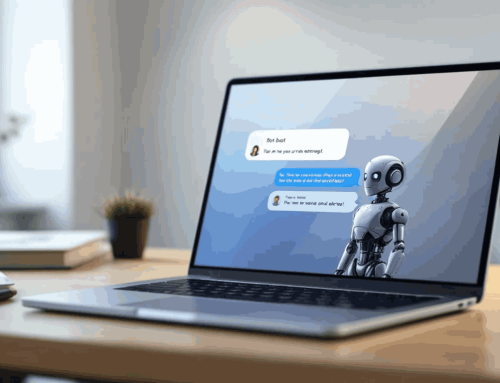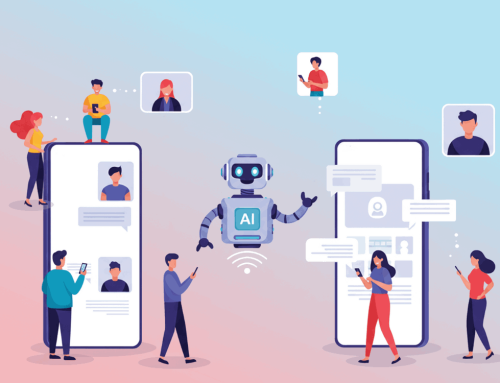AI Agents have come a long way from the simple scripted interactions of the past. In today’s digital‑first world, customers expect intelligent, responsive, and seamless experiences across every channel. To meet these rising expectations, businesses must implement chatbot features that are not only advanced but aligned with their customer experience strategy.
With the right mix of chatbot features, your business can automate key touchpoints, offer 24/7 support, personalise engagement, and scale services without compromising quality. Whether you’re looking to enhance your existing CX strategy or build one from scratch, this guide will help you identify the must‑have capabilities that truly make a difference.
Why Chatbot Features Matter for Your CX Strategy
Customer experience (CX) is now a key differentiator for brands across nearly every industry. According to multiple studies, a positive CX drives loyalty, increases customer lifetime value, and enhances brand perception. Conversely, a poor experience — even during a single interaction — can quickly push customers toward competitors.
This is where chatbot features become critical. Far beyond simple question-and-answer bots, today’s advanced chatbots are sophisticated digital agents that enhance the customer journey. By selecting the right features, you can:
- Provide immediate responses 24/7
- Personalise interactions at scale
- Reduce friction in support journeys
- Gather actionable insights through analytics
- Strengthen customer loyalty through seamless experiences
Ultimately, chatbot features enable businesses to deliver consistent, high‑quality service that meets customer expectations — a cornerstone of any modern customer experience strategy.
Key AI Capabilities Every Chatbot Should Have
At the heart of any effective chatbot is its AI engine. The quality of a chatbot’s artificial intelligence directly influences how naturally it can interact with users and how effectively it can resolve queries. Here are the AI‑driven chatbot features that every business should prioritise:
Natural Language Processing (NLP)
Natural Language Processing allows a chatbot to interpret and understand human language — both written and spoken. It enables chatbots to grasp context, detect user intent, and handle variations in phrasing, slang, and grammar. Without robust NLP, your chatbot will deliver a rigid, frustrating experience that falls short of customer expectations.
Intent Recognition
Intent recognition is what lets the chatbot identify what the user is trying to accomplish — be it placing an order, getting account information, or troubleshooting an issue. Advanced intent recognition ensures that your chatbot routes the conversation accurately and provides relevant solutions quickly.
Context Awareness
Context-aware chatbot features allow the bot to remember past interactions, user preferences, and conversational flow. This creates a more seamless, human‑like experience and avoids repetitive or irrelevant responses. Context awareness is essential for driving customer satisfaction and building loyalty.
Machine Learning and Continuous Improvement
A modern chatbot should not remain static. By leveraging machine learning, it can continually analyse interactions, learn from them, and improve over time. This ensures your chatbot evolves with your business and customer needs, providing more accurate and helpful responses in future conversations.
Top Conversational UX Features to Drive Engagement
An intelligent chatbot is only as good as its user experience (UX). Even the most advanced AI will fall flat without a well‑designed conversational flow. To engage customers and keep them coming back, your chatbot must deliver a smooth, intuitive experience. The following chatbot features play a vital role in conversational UX:
Human‑Like Dialogue Flow
Customers prefer interactions that feel natural. Your chatbot should avoid robotic scripts and instead mimic the tone, pacing, and flow of real human conversations. Using dynamic responses and conversational cues helps keep engagement high and prevents user frustration.
Quick Replies and Smart Suggestions
Quick replies and smart suggestions provide users with pre‑set response options, streamlining the interaction. This reduces typing effort, speeds up resolution, and improves the overall customer experience. It’s particularly useful for mobile interactions, where simplicity is key.
Personalised Conversations
Chatbots with personalisation features can greet customers by name, reference past purchases, and offer tailored recommendations. Personalisation fosters connection and loyalty, enhancing the emotional component of your customer experience strategy.
Visual Elements: Buttons, Carousels, and Rich Media
Strong conversational UX also incorporates visual components — such as buttons, image carousels, and videos — to make interactions more engaging and informative. These chatbot features help break up text and guide users towards desired outcomes more efficiently.
Error Handling and Fallback Responses
No chatbot is perfect, but how it handles errors can make or break the user experience. A good chatbot gracefully manages misunderstandings with helpful fallback messages, ensuring the conversation continues smoothly and without frustration.
Essential Integration Features for Seamless CX
A chatbot does not operate in a vacuum. To truly enhance your customer experience strategy, your chatbot must integrate seamlessly with your existing systems and digital touchpoints. The following integration-related chatbot features are crucial for delivering frictionless customer journeys:
CRM and Customer Data Integration
Integration with your CRM allows the chatbot to access and update customer records in real time. This enables personalised conversations, faster resolutions, and a single source of truth for customer data — all of which are vital for a cohesive CX.
Support Ticketing and Helpdesk Systems
For more complex queries that require human assistance, chatbots must integrate with ticketing and helpdesk platforms. This ensures smooth hand-offs, continuity of service, and proper escalation, providing customers with a seamless support experience.
E‑Commerce and Payment Systems
For retail and e‑commerce businesses, chatbot features that support product searches, order updates, stock checks, and payment processing can significantly enhance the shopping experience. Customers can complete transactions directly within the chat, removing barriers to purchase.
Omnichannel Integration
Modern customers expect to move between channels without repeating themselves. Omnichannel chatbot integration ensures conversations can continue across web, mobile, social media, messaging apps, and voice assistants, providing consistency throughout the journey.
Internal Knowledge Bases and Document Repositories
A chatbot connected to your knowledge base can provide more accurate answers and reduce the load on human agents. Integration with FAQs, manuals, and other documentation empowers the bot to resolve common queries quickly and efficiently.
Multilingual Chatbot Features for Global CX
In an increasingly global marketplace, brands must be prepared to engage with customers across different regions, cultures, and languages. Multilingual chatbot features are essential for businesses looking to support international audiences and deliver inclusive experiences. Here’s why these capabilities matter:
Real‑Time Language Detection
An effective multilingual chatbot should automatically detect the user’s language — either from their input, profile, or device settings — and respond accordingly. This creates a more personalised and welcoming experience right from the first interaction.
Support for Multiple Languages and Dialects
Your chatbot should be capable of handling a wide range of languages, including regional dialects where appropriate. The broader your language coverage, the more markets you can serve. Ensure that translations are accurate, localised, and culturally sensitive to avoid miscommunication.
Seamless Language Switching
Many customers today are multilingual themselves. Advanced chatbot features should allow for seamless switching between languages mid‑conversation, ensuring a fluid experience for users who may prefer different languages for different topics.
Consistency Across Markets
Multilingual chatbot capabilities help maintain brand consistency across global markets. Whether a customer is engaging with your chatbot in London, Berlin, or Singapore, they should experience the same tone, quality, and efficiency.
Chatbot Analytics and Performance Tracking
Deploying a chatbot is just the beginning. To truly transform your customer experience strategy, you need to continuously monitor, analyse, and optimise how your chatbot performs. Built-in analytics and reporting chatbot features provide the insights required to refine conversations, improve outcomes, and drive ongoing CX success.
Here are the key analytics capabilities to look for:
Interaction Metrics and User Journeys
Track how users interact with your chatbot — including conversation flows, drop-off points, popular queries, and session length. This helps identify friction in the user journey and opportunities to improve the conversational design.
Resolution and Deflection Rates
Monitor how often the chatbot successfully resolves queries versus how often conversations are escalated to human agents. High resolution rates signal that your chatbot features are delivering value and reducing support costs.
Customer Satisfaction (CSAT) Scores
Collect post-interaction feedback and CSAT scores to gauge how satisfied customers are with their chatbot experiences. This provides direct insights into how the bot is impacting your overall customer experience strategy.
Sentiment Analysis
Advanced chatbots can analyse user sentiment — whether positive, neutral, or negative — during conversations. Sentiment tracking helps you understand customer mood in real time and fine-tune the chatbot’s tone and responses.
Performance Benchmarking
Compare chatbot performance across different time periods, regions, or customer segments. This allows you to identify trends, measure improvements, and align chatbot performance with broader CX goals.

Security and Compliance Features
Trust is a vital component of any customer experience strategy — and this is especially true when chatbots handle sensitive customer data. To ensure your chatbot builds trust and complies with regulations, it must incorporate robust security and compliance features.
Here are the essentials:
Data Encryption
All data transmitted between the chatbot and users should be encrypted — both in transit and at rest. This prevents unauthorised access and ensures that personal information remains protected.
GDPR and Regulatory Compliance
If your chatbot operates in the UK or EU, GDPR compliance is mandatory. Key chatbot features should include clear consent mechanisms, transparent data usage policies, and easy options for users to request data deletion.
User Authentication
For interactions involving account details, transactions, or personal data, strong user authentication (such as two-factor authentication or secure login prompts) is crucial to prevent fraud and unauthorised access.
Secure Integrations
Your chatbot must maintain security across all its integrations — whether it’s connecting to CRM systems, payment gateways, or support platforms. Look for chatbot features that include secure API connections and rigorous access controls.
Audit Trails and Logging
To support compliance and incident tracking, your chatbot should maintain detailed logs of interactions and system activity. This creates transparency and provides valuable data for audits and security reviews.
Automated Customer Service at Scale
As businesses grow, so does the volume of customer interactions. Scaling human support teams can be costly and inefficient — this is where automated chatbot features can truly transform your customer experience strategy. The right features allow you to deliver consistent, high‑quality service to thousands (or millions) of customers simultaneously.
Here’s how:
24/7 Availability
One of the most valuable chatbot features is 24/7 availability. Customers expect support on their own schedule — not just during business hours. An always‑on chatbot ensures that users can get answers, resolve issues, or make purchases anytime, day or night.
High‑Volume Query Handling
Chatbots can handle massive volumes of simultaneous conversations without performance degradation. Whether during peak periods, seasonal spikes, or product launches, chatbots help maintain a consistent CX without increasing operational costs.
Automated Workflows and Process Handling
Advanced chatbot features can go beyond answering FAQs — they can trigger complex workflows such as booking appointments, processing returns, or updating user accounts. Automating these processes not only saves time but also improves consistency and accuracy.
Hybrid Chat: Smooth Agent Handover
No chatbot can handle 100% of queries. A well‑designed hybrid model allows for seamless handover to live agents when needed, complete with conversation history. This ensures that customers never feel abandoned or forced to repeat themselves.
Consistency Across Interactions
Automation ensures that each customer receives consistent information and service — no matter when they interact, how many queries they make, or which channel they use. This consistency is key to building trust and reinforcing your brand’s CX strategy.
How to Choose the Right Chatbot Features for Your Business
With so many available options, selecting the right chatbot features can feel overwhelming. However, a clear understanding of your customer needs, business objectives, and CX strategy will help you prioritise which capabilities matter most.
Follow these steps to choose the best chatbot features for your organisation:
1. Define Your CX Goals
Start by mapping out your customer experience strategy. Are you aiming to improve first-contact resolution rates? Reduce support costs? Drive sales? Enhance personalisation? Your objectives will shape the chatbot features you need.
2. Understand Your Audience
Analyse your customers’ preferences, languages, and channels. For example, if your audience frequently uses mobile apps, prioritise chatbot features optimised for mobile UX. If you serve global markets, multilingual capabilities become essential.
3. Evaluate Existing Tech Stack
Assess how your chatbot will integrate with current systems — CRM, e‑commerce platforms, helpdesk tools, and data repositories. Seamless integration is one of the most valuable chatbot features for creating a connected CX.
4. Prioritise Scalability and Flexibility
Look for chatbot features that support growth and adaptability. Your needs will evolve, so choose platforms that allow you to add new features, channels, or workflows over time without major redevelopment.
5. Test and Iterate
Run pilot programmes and analyse the performance of your chatbot. Continuous optimisation is crucial — so prioritise chatbot features that provide detailed analytics and support iterative improvement.
Frequently Asked Questions
What are the most important chatbot features for improving customer experience?
The most important chatbot features include natural language processing, context awareness, seamless CRM integration, personalisation, omnichannel support, and advanced analytics. These capabilities ensure your chatbot delivers value at every stage of the customer journey.
How do chatbot features contribute to automated customer service?
Chatbot features such as 24/7 availability, automated workflows, and the ability to handle high volumes of queries allow businesses to scale support without sacrificing quality. Automation ensures faster response times and more consistent customer service.
Why is personalisation one of the key chatbot features?
Personalisation helps humanise interactions. Chatbot features that incorporate user data, past interactions, and customer preferences enable bots to offer more relevant responses — enhancing satisfaction and loyalty.
Are multilingual chatbot features essential for all businesses?
Not all businesses require multilingual chatbot features, but for brands operating in multiple regions or serving diverse audiences, multilingual capabilities are critical for inclusivity and global CX excellence.
How can chatbot features support sales and marketing?
Beyond customer service, chatbot features such as product recommendations, guided selling, personalised offers, and seamless checkout flows can drive conversions and boost revenue. The chatbot becomes a valuable sales channel when equipped with the right features.
What advanced chatbot features help ensure compliance with data privacy regulations?
Security-focused advanced chatbot features — including data encryption, user authentication, GDPR compliance options, and audit trails — are essential for protecting sensitive customer data and building trust.
How do chatbot features support hybrid human‑bot models?
Hybrid chat combines automation with human empathy. Chatbot features such as smooth agent handovers, conversation history sharing, and fallback responses ensure that customers move between bots and live agents without disruption.
What analytics chatbot features should I prioritise?
Key analytics chatbot features include sentiment analysis, resolution tracking, conversation flow mapping, and CSAT collection. These tools provide actionable insights to improve chatbot performance and CX outcomes.
How often should I update my chatbot features?
Continuous improvement is best. Monitor performance data and user feedback regularly, and update chatbot features to address new customer needs, technologies, or market conditions.
Ready to transform your customer experience with the right chatbot features
At Smart Digitants, we help businesses design, implement, and optimise chatbots that deliver real results. Whether you’re starting from scratch or enhancing an existing solution, we’ll ensure your chatbot features align with your CX strategy and drive measurable impact.
Get in touch with us today to start building a smarter, more effective customer experience.
Our Content Writing Team at Smart Digitants is a group of dedicated professionals, passionate about creating high-quality, engaging content.
- Why Chatbot Features Matter for Your CX Strategy
- Key AI Capabilities Every Chatbot Should Have
- Top Conversational UX Features to Drive Engagement
- Essential Integration Features for Seamless CX
- Multilingual Chatbot Features for Global CX
- Chatbot Analytics and Performance Tracking
- Security and Compliance Features
- Automated Customer Service at Scale
- How to Choose the Right Chatbot Features for Your Business
- Frequently Asked Questions
- Ready to transform your customer experience with the right chatbot features










